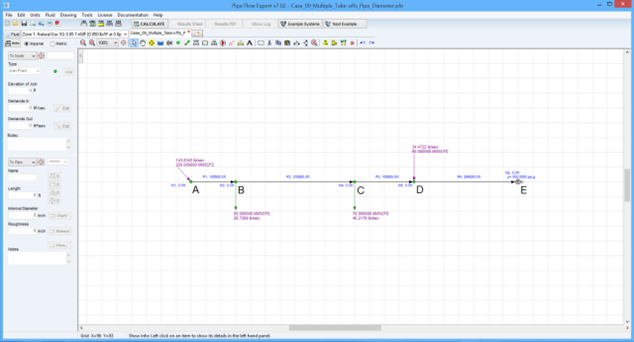Case 09: Natural Gas Pipeline Outlet Pipe Diameter with Multiple Take-Offs
Reference: Gas Pipeline Hydraulics, 2005, CRC Press, E. Shashi Menon Chapter 3, page 94 Example 2b
Pipe Flow Expert File: Case_09_Multiple_Take-offs_Pipe_Diameter.pfe
Problem Description:
A 150 mile pipeline carrying methane consists of several injections and deliveries, as shown in the screen image.
The pipe internal diameter is 19 inches and at point A has an inlet volume of 250 MMSCFD.
At point B (20 miles downstream of the inlet) 50 MMSCFD is delivered and at point C (80 miles downstream of the inlet) 70 MMSCFD is delivered.
At point D, 100 miles downstream of the inlet, gas enters the pipeline at 60 MMSCFD.
Point E represents the end of the pipeline, 150 miles downstream of the inlet.
Calculate the pipe diameter that will be required for section DE if the required delivery pressure at E is increased to 500 psi.g and the inlet pressure at A is the value that was calculated in Case 08. Assume a drag factor of 0.96 and a compressibility factor of 0.85 throughout.
The calculation method used for the published data was the American Gas Association (AGA) equation.

Pipe Flow Expert Parameters:
Fluid Data: Gas with gravity 0.65 (0.04964 lb/ft3), 60 °F at 0.00 psi.g, viscosity 0.0119 centipoise.
Pipe Data: Roughness 150 micro-inches.
Calculation Method: AGA Isothermal Flow equation, with 0.96 drag factor, Node Adjust Method.
Standard Atmospheric Model: 60°F, 14.696 psi.
Gas Physical Model: Real Gas Model (Ideal Gas Law with custom compressibility factor Z=0.85).
Result Comparison:
|
Data Item |
Published data |
Pipe Flow Expert |
|
Pipe Diameter of DE section (inches) |
23.79 |
23.95 |
Commentary:
The published data and the calculated results compare well.
The pipe diameter calculated was that needed to produce an inlet pressure of 924.18 psi.g (which corresponds with the Pipe Flow Expert result in the previous example). The calculations for the published results used an approximation by re-using the AGA transmission factor from the previous example for all of the other pipe sections, whereas Pipe Flow Expert correctly calculates the AGA transmission factor separately for each pipe section.

